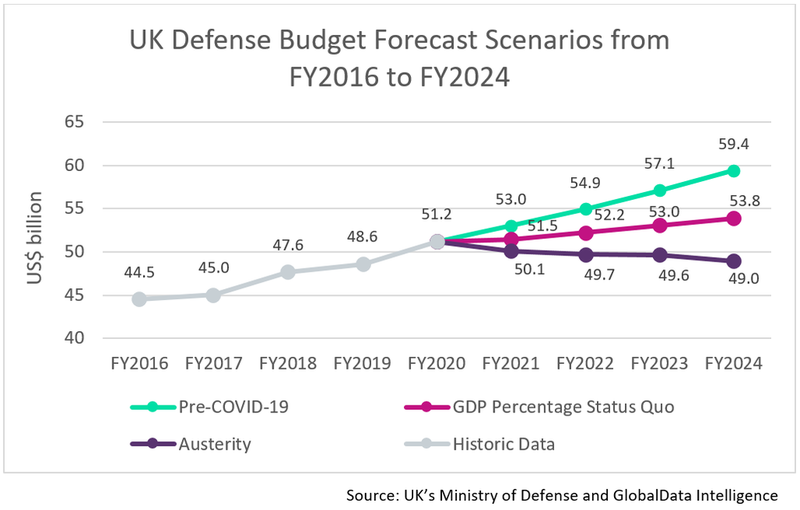air
Comment & Analysis
How Covid-19 could affect the UK's defence budget
GlobalData explores different impact scenarios of Covid-19 on the UK's defence budget up to 2024.
Royal Air Force (RAF) engineer Sue Gray was promoted to the rank of Air Marshal in February, making her a three-star commander and the most senior female military officer in the British Armed Forces. Berenice Baker talks to Gray about her career in the RAF and the importance of inspiring girls and young women into engineering careers.
// Image: Sue Gray
Lorem ipsum dolor sit amet, consectetur adipiscing elit. Suspendisse laoreet nunc rutrum leo iaculis, sed dignissim eros venenatis. Nullam et semper lorem. Nulla facilisi. Donec placerat nisi sed urna convallis, in suscipit ex sollicitudin. Etiam vehicula justo ac tellus luctus elementum. Sed tincidunt euismod finibus. Pellentesque habitant morbi tristique senectus et netus et malesuada fames ac turpis egestas. Sed vitae eros in dolor tempor finibus. Cras convallis egestas ipsum et faucibus. Praesent fringilla erat in orci fermentum laoreet. Nullam at neque in sem vehicula congue ut nec ipsum.
With the UK in relatively early stages of the Covid-19 pandemic, a substantial level of uncertainty surrounds the country’s defence budget in the coming years. Budget predictions are frequently based on GDP projections and government statistics on spending, the updates of which only precipitate further into a crisis such as Covid-19. Subsequently, it is challenging to provide one single forecast for the forthcoming fiscal years.
The impact of Covid-19 is largely dependent on the duration of its spread, particularly whether its effects can be mitigated earlier or later. Taking these factors into account, GlobalData explores three potential scenarios for the UK defence budget up until Fiscal Year (FY) 2024: the pre-Covid-19 scenario, a GDP percentage status quo scenario, and an austerity scenario.

Pre-Covid-19 scenario
The best outcome for the UK’s defence budget in the wake of the coronavirus crisis would see a continued budget increase following the growth in actual terms forecasted prior to the pandemic.
This forecast would align with a scenario where the UK’s GDP is largely unaffected by Covid-19, but this is not a necessary requirement as the government may decide to maintain pre-Covid 19 levels of spend regardless. The UK is committed to devote close to 2% of its GDP to defence (1.87% in FY 2020 according to GlobalData), which would therefore ensure a steady defence budget growth over the forecast period.
This scenario is unlikely as the Covid-19 pandemic is almost certain to negatively impact the UK’s economy for more than the short-term period this model would require.
GDP percentage status quo scenario
The GDP status quo scenario is arguably the most likely for the UK in the medium term.
This scenario shows a GDP growth slowdown starting in FY2020 due to the Covid-19 pandemic, but with the UK maintaining the percentage of GDP committed to defence prior to the crisis. There are many reasons why this may occur, but the main ones regard the current levels of committed spend in the equipment pipeline as well as the general importance of the UK defence industry in supporting the wider economy.
The UK is heavily invested in numerous long-term procurement projects, many of which will not be cut due to contractual obligations and the need for the military capabilities that they will provide. The Dreadnought-class submarine, key to the UK’s nuclear deterrence strategy, is an example of this. The UK will spend $1.3bn on the project in FY2020 alone, and this commitment is certain to be protected over the forecast period.
Austerity scenario
Due to its involvement in many operations abroad, the UK will need to maintain a substantial level of defence funding even within an austerity scenario.
The UK remains keen to meet NATO’s target of spending 2% of GDP on defence, and whilst this might not be fully achievable in an austerity scenario, the need to meet international commitments will remain at the forefront of governmental plans. Having previously adjusted the margins of submission to NATO when reporting this 2% figure in recent years, limited leeway now exists for further creative accounting.
As such, even in an austerity scenario the percentage of GDP that the UK is forecast to spend on defence only drops to 1.7% by FY2024. This equates to a defence budget of $49bn in FY2024, instead of the %59.4bn forecast in the pre-Covid-19 scenario. The figure assumes a drop in the growth rate of the UK’s GDP at the end of FY2020 due to the economic impact resulting from measures taken to address the Covid-19 crisis.